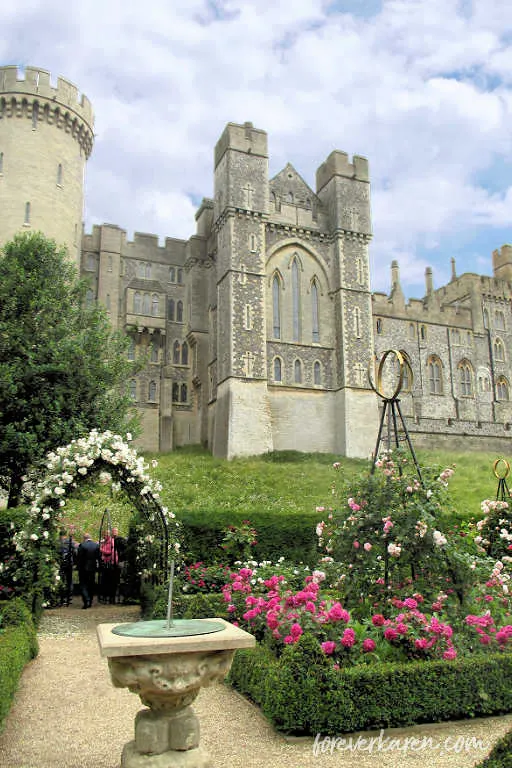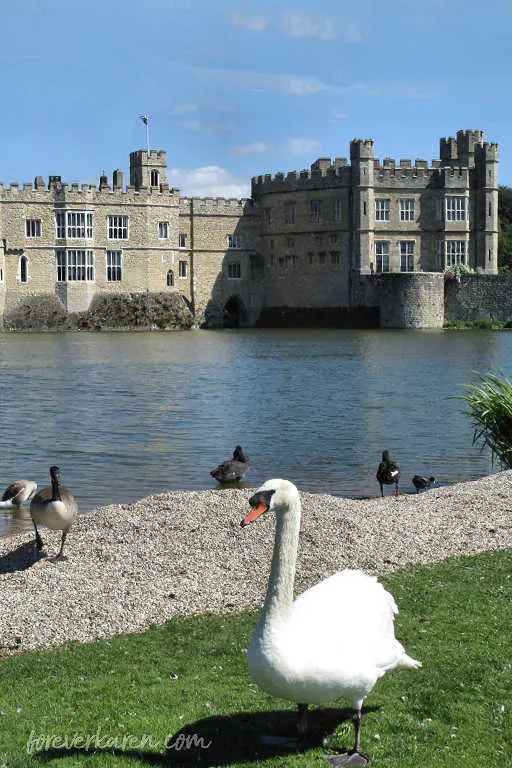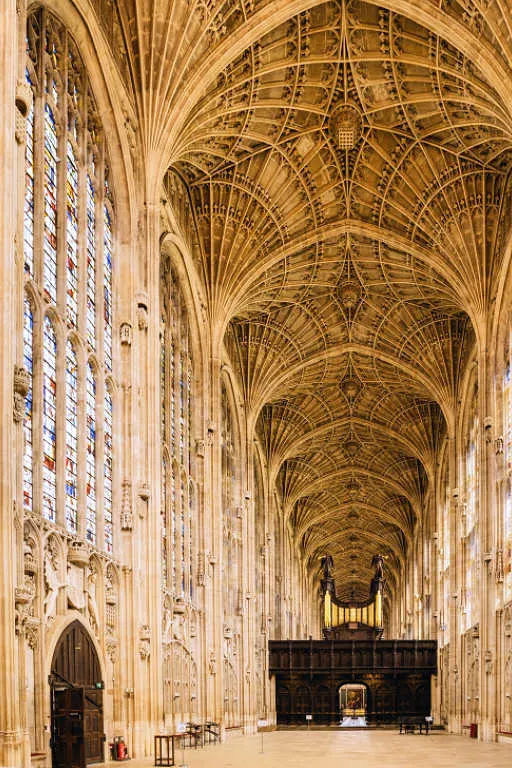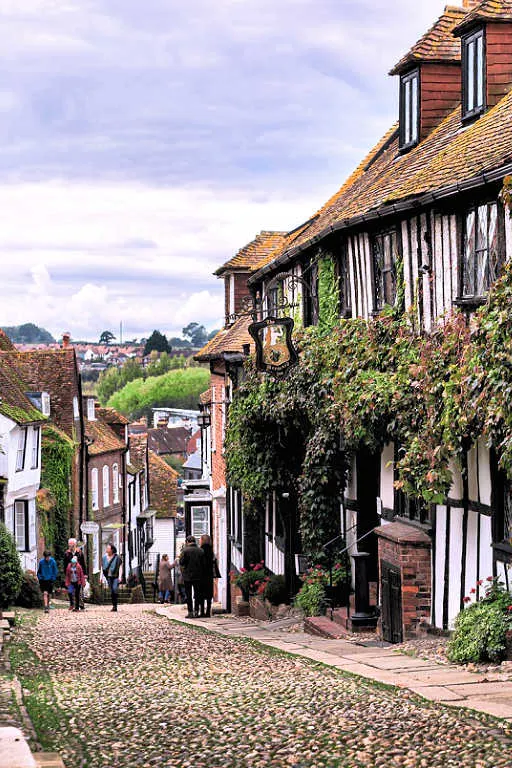
Great Britain has one of the oldest railway systems globally, and although over a century old, it’s very reliable. With the ability to travel far and wide, travelers staying in London can explore areas of England on day trips.
For travelers from other countries, train travel allows for transit, without taking to the ‘other side of the road’ by car.
If you purchase a BritRail Pass, you can ride by train any time of the day. Without a pass, rail tickets are more expensive on weekdays, especially during peak times. So, plan to travel outside of rush hour to save money.
I found it relaxing to travel around Britain by train. As the train traveled between towns, I enjoyed the rolling hills and checkerboard pastures featured in Constable and Turner paintings.
So, from quaint villages oozing with character to abandoned British castles filled with history, take your pick of these best train trips from London.
Hampton Court
- Stations: Waterloo to Hampton Court | Time: 45 mins
With less than an hour train ride, Hampton Court provides an easy excursion without traveling too far. With a five-minute walk from the train station, you can explore the ancient history and stunning gardens of Hampton Court Palace.
Steeped in history, palace goers can learn about its famous former resident, King Henry VIII, who brought all six wives to Hampton Court. Once a country home, Henry VIII’s Lord Chancellor, Cardinal Thomas Wolsey, transformed Hampton Court into a magnificent palace.
Later, it underwent many more renovations. The residence, fit for royalty, hosted lavish banquets and happy events. But it also holds a history of sorrow. Henry VIII lost two of his wives there. Jane Seymour died twelve days after giving birth to their son, and Henry beheaded Catherine Howard for adultery.
Outside the palace walls, the estate features a vast woodland, of which 60 acres were reserved for formal gardens and includes a maze. The initial hedge maze, first planted with hornbeam, has been replaced with dense yew trees.
As the oldest surviving hedge maze in England, it has delighted visitors with its multichannel pathways since the 1700s. With an average time of 20 minutes to complete the maze, are you ready to take on the challenge?
Blenheim Palace
- Stations: Marylebone to Oxford Parkway | Time: 1 hr 30 mins

Although not owned by the British Royal family, Blenheim Palace’s claim to fame is Winston Churchill’s birthplace. Located near Oxford, England’s grand estate mesmerizes visitors with its manicured gardens, opulent staterooms, and ancient history.
Today, the Duke of Marlborough resides in the palace. However, visitors can see many of the rooms, including the Great Hall, Long Library, and guest bedrooms.
The Churchill’s Life Exhibition allows visitors to delve into the life of Sir Winston Churchill. With photographs, artifacts, and memorabilia, you’ll understand why the home was one of his favorite places.
I highly recommend the Churchill War Rooms, a hidden gem in downtown London for those wanting to learn more. In the underground war bunkers, you’ll see where Churchill and his cabinet lived during the Second World War.
Outside, the palace’s grounds, designed in the early 18th-century, exude so much beauty with cascading fountains, traditional English gardens, and a fun hedge maze.
Today, the stunning water terraces and formal rose gardens still give visitors that wow factor. For families, the Marlborough Maze, Butterfly House, and miniature train will entertain the little ones for hours.
Seven Sisters Cliffs
- Stations: Victoria to Eastbourne | Time: 1 hr 25 mins
While Dover is famed for its chalky white Cliffs, those staying in London can see similar cliffs without a lengthy journey.
Located between Eastbourne and Brighton, the Seven Sisters Cliffs are just as spectacular and provide a beautiful day trip to places in England’s south, for those wanting to escape the crowds of London.
The iconic white cliffs made of limestone are receding at a rate of 70 cm a year. As the rain, ice, and waves attack the cliffs, the edges remain sharp with crisp white hues. On top of the cliffs, popular walking trails offer strollers outstanding views of the ocean and Sussex countryside.
With endless sea views, you can walk for hours along the seven ridges. Stairs down to the pebbled beach allow children to play beneath the cliffs, while the nearby café offers refreshments when you need a break.
While you can visit the Seven Sisters Cliffs year-round, visitors should avoid winter and bad weather due to wind. In the late spring and summer, visitors can enjoy wildflowers along the walking trails.
Brighton
- Stations: Victoria, London Bridge or Blackfriars to Brighton | Time: 1 hr
If you’re looking to escape to the coast, there’s no better place than Brighton. Directly south of London, day-trippers can reach Brighton on a rapid train in an hour.

Known as one of Sussex’s best treasures, Brighton offers an eclectic mix to suit everyone. While the beaches don’t have soft sand, beachgoers can rent a lounger to enjoy the sun’s rays.
Nearby, a Brighton icon, the Brighton Pier attracts visitors to play its arcade machines and laugh on carnival rides. With tempting fish and chips, candy floss, and candy apples, be sure to watch out for the hungry seagulls who aim to share your food.
Close to the beach, The Lanes are a collection of narrow alleyways filled with unique boutiques and cafes. The shops are housed in 17th and 18th-century buildings, and it’s fun to browse the independent stores in a network of tapered walkways.
Brighton’s most popular attraction, the Royal Pavilion, amazes travelers with its unusual architecture. Its kaleidoscopic design mixes an Indian exterior with an Asian Interior.
Once the holiday home of King George IV, visitors can enjoy the opulent rooms, including a state-of-the-art kitchen for its time. Built in 1816, it features tall ceilings with skylights, running water, and almost modern cooking facilities.
Oxford
- Stations: Marylebone or Paddington to Oxford | Time: 1 hr
Just a one-hour train ride from London, Oxford might be one of England’s most popular day trips. In Oxford, visitors can step back in time as if immersed in an ancient novel. With a 1000-year-old castle, renowned university colleges, and numerous museums, a day trip to Oxford might not be enough time.
As one of Oxford’s most photographed buildings, the Radcliffe Camera remains an iconic landmark with its circular structure. Built in the 1700s, the building now houses a library adjacent to the Bodleian Library.
Many know the Bodleian Library as a filming location for Harry Potter. It was transformed into the Hogwarts Library during filming, while the Hogwarts Infirmary was filmed at the Divinity School.
At Christ Church, the dining hall inspired the Hogwarts Great Hall. Potter fan or not, Christ Church is a must-visit. With so much to see, don’t miss out on the Christ Church Cathedral, stunning cloisters, and stroll the Great Quadrangle.
With an impressive collection of museums, a visit to Oxford isn’t complete without seeing at least one. The Oxford Museum of Natural History features a fantastic display of dinosaurs, while the Ashmolean Museum houses world-famous exhibits from mummies to modern-day artifacts.
Those that want a break from sightseeing might want to punt on the River Cherwell. Punting uses a flat-bottomed boat and a punt or pole. Propulsion happens when you push off the river bed allowing the punt to move, slowing down the river.
Arundel
- Stations: Victoria to Arundel | Time: 1 hr 30 mins
To the south of London, a train trip to Arundel offers a magnificent medieval castle, a charming town, and a historic cathedral. Located in West Sussex, Arundel oozes character and appeal. Visitors can reach its centerpiece attraction, Arundel Castle and grounds after a 15-minute stroll from the station.

While the castle doesn’t open until noon, early arrivals can enjoy the Fitzalan Chapel on the castle grounds. Every inch of the 40 acres of gardens is meticulously cared for, with my favorite being the Collector Earl’s Garden.
With serene water fountains, domed pergolas, and various perennials, it’s a horticultural utopia.

The inner walls of the castle are as spectacular as the outside. Home to the Duke and Duchess of Norfolk, the opulent guest rooms and Great Hall are amazing.
One of the best parts of the castle is the 17th-century Norman Keep. The reward for climbing 131 stairs is unabated views of River Arun, Arundel, and the rolling hills of West Sussex.
Should you have time, be sure to explore the antique shops and charming boutiques in the town. For those with a sweet tooth, pop into Castle Chocolates to taste their chocolates and fudge. In the center of Arundel, Cockburn’s Tea Room offers a splendid afternoon tea with scones and clotted cream.
Windsor
- Stations: Waterloo to Windsor | Time: 1 hr
Outside London, the small town of Windsor features the iconic Windsor Castle. Known as Queen Elizabeth II’s weekend retreat, the castle estate has hosted numerous royal weddings, including that of Prince Harry and Meghan Markle. Should you arrive early, you can watch the traditional ceremony of ‘the changing of the guards.’
At 900 years old, the stone-walled castle has stood the test of time, although, in 1992, it suffered a devastating fire. Afterward, it took several years and almost GBP37 million to restore the castle to its former glory.
Inside the walls, the Queen Mary’s Dollhouse mesmerizes visitors with its size and intricate details. With electricity and running water, it’s a miniature house made for royalty.
Admission to the estate includes the State Apartments, Castle Precincts, Moat House, St. George’s Chapel, and more. Between September and March, your ticket provides access to the Semi-State Rooms used by the Queen for official engagements.
Behind the castle, the iconic Royal Mile stretches three straight miles through Windsor Great Park. Here, over 500 deer call the park their home. Across the River Thames, the historic town of Eton is home to the famous Eton College.
The town of Windsor has so much history, which is evident in its buildings. The leaning stance of the Crooked House makes you wonder how the structure still stands.
Opposite Windsor Castle, a 19th-century train station houses a collection of interesting shops and cafes. It’s a perfect stop to get some refreshments before the returning train journey to London.
Leeds Castle
- Stations: Victoria to Bearstead | Time: 1 hr 10 mins

With over 900 years of incredible history, Leeds Castle enchants its visitors with its fairy tale persona. Located in Kent, the poetic structure oozes with romance surrounded by a moat and acres of lush woodland. After your first visit, you’ll agree that its title as ‘The loveliest castle in the world’, is quite fitting.
Initially, the estate was built as a military stronghold. It later became home for six Queens and was used during the war as a hospital. In the 17th-century, the castle was sold to a private owner and has remained privately owned until recently.
Its last owner, Lady Baillie, established the Leeds Castle Foundation, which has maintained the estate since her death. Today, the castle remains empty, which allows visitors to see almost every stateroom.
Sometimes though, the foundation closes some parts of the castle for events. During my last visit, the dining room was hosting an intimate wedding.
The Leeds Castle estate has 500 acres of land. To the back of the castle, terraced gardens, a falconry center, and a yew tree maze add hours of entertainment. Once you reach the center of the maze, you exit through an underground grotto featuring strange creatures made of wood and shells.
While some castles take an hour or two to visit, prepare to spend your whole day at the Leeds Estate.
Warner Bros. Studio
- Stations: Euston to Watford Junction | Time: 20 mins
Since the Warner Bros. Studio opened the Making of Harry Potter exhibit in 2012, Potter fans have been flocking to London to experience a piece of its magic. With over 5,000 visitors a day, the Making of Harry Potter is arguably a must-do day trip from London.
Potterheads often show up in costume to immerse themselves in the magic of Diagon Alley. Who knows, maybe you’ll be riding the train from London filled with tourists in cloaks and toting wands?
Even if you’re not a Potter fan, everyone enjoys the interactive exhibits and learning what brought the characters to life. Be prepared to spend over three hours touring its sets, learning about digital effects, seeing its props, and admiring the costumes.
Since the Warner Bros. Studio tour is a popular destination, book your tickets online a month or two before your visit to prevent disappointment.
Cambridge
- Stations: King’s Cross, Liverpool Street or St. Pancras to Cambridge | Time: 45 mins
With just a 45-minute train ride from London, a Cambridge day trip is easy and allows for another history lesson. Like Oxford, most know Cambridge for its famous university. In fact, the colleges that make up Cambridge University take up half of the town’s center.

Here, just a 20-minute walk from the train station, you’ll be engulfed in breath-taking Gothic architecture. Although, there’s none quite as spectacular as Kings College Chapel with its stained-glass, van ceiling, and historical artwork.
Most of the colleges back onto the River Cam with unique bridges to cross to the other side. The Mathematical Bridge has an attractive curved shape, although constructed from pieces of straight lumber.

Another, the Bridge of Sighs, resembles a similar model in Venice, Italy. So, rent a punt and enjoy a float down the river as you sail under these marvelous bridges.
Built in the 12th-century to resemble the Jerusalem structure of the same name, the Church of the Holy Sepulchre is a must-see. The iconic ‘Round Church’ has a circular nave and a cone-shaped spire. Since the congregation outgrew its church, the structure now houses a Christianity exhibit.
Canterbury
- Stations: St. Pancras to Canterbury | Time: 1 hr 10 mins
Canterbury Cathedral, a UNESCO World Heritage Site, is one of England’s oldest Christian cathedrals. It’s also home to the Archbishop of Canterbury, who rules over the Anglican Church.
The initial church was built in 597 AD, but after a few fires, the city rebuilt the structure with a Gothic influence instead of the previous Romanesque style.
Visitors might be surprised by the cathedral’s size. Inside, the rooms seem to go on forever, so expect to spend a few hours touring the structure. Whether you take a guided tour or not, remember to look up at the stunning ceilings and magnificent stained-glass windows.
Some highlights of Canterbury Cathedral include the Crypt, The Choir, and the Martyrdom, which marks the spot where Archbishop Thomas Beckett was killed.
Close to the cathedral, the ruins of St. Augustine Abbey beg for exploration. Built around the same time as the cathedral, the Abbey served as a monastery and became the resting place for several Kent kings.
Should you have the time, the Westgate Towers are a worthy stop. You only need 30-minutes to tour the largest surviving Medieval gateway in Britain.
Stonehenge
- Stations: Waterloo to Salisbury | Time: 45 mins

At 5,000 years old, there are few places in England as iconic as Stonehenge. The British landmark attracts over 1.5 million visitors a year to admire the giant stones standing ‘on guard’ in a field.
The mystery of how the rocks got there and why it was built is still debated. Admission to Stonehenge includes visiting the famed circle of rocks and a relatively new informational center.
On the UNESCO World Heritage property, the visitors center features lots of artifacts recovered from the area surrounding Stonehenge. Since archaeologists have excavated only half the site, there could be new discoveries in the future.
Outside the visitors’ center, Neolithic Houses built of chalk walls and thatched roofs demonstrate how the builders of Stonehenge lived. Nearby, a giant stone positioned on rolling logs suggests how people moved the monument stones.
Hastings
- Stations: London Bridge to Hastings | Time: 1 hr 30 mins
The medieval town of Hastings gave its name to the famous Battle of the same name.
While the Battle of Hastings took place at Battle Abbey, six miles away, visitors can learn about the 1066 historic event at the Hastings Castle. Reached by the West Hill Lift or funicular railway, the castle offers excellent beach and town views.
Being on the coast, Hastings became a popular place for smuggling. Located on the West Hill, the St. Clements Caves relives the life of a smuggler through interactive exhibits in the sandstone caves.
As you weave through a series of underground tunnels, you’ll meet the bootleggers, pirates, and smugglers who made their living in those caves.
Two 18th-century masterpieces, the Circus and Royal Crescent are found in Bath. Both circular in construction, the Georgian townhomes of the Circus create a full circle, while the latter forms a semi-circle.
Constructed by John Wood, the Elder, and the Younger, both residential streets are a marvel in design. While some owners have converted some homes to flats, the frontal exteriors have remained the same.
Bath
- Stations: Paddington to Bath Spa | Time: 1 hr 30 mins
From the Roman Baths to the stunning Royal Crescent, Bath is a city with a rich heritage. The gorgeous Georgian buildings made of butter-colored limestone reminded me of the Cotswolds. Thermal water was believed to heal the sick during Roman times, so Roman Spas were built for bathing.

Today, visitors can walk in the footsteps of the Romans. At the Roman Baths, you’ll see ancient artifacts, such as goddess Sulis Minerva’s bronze head, admire the Temple of Sulis Minerva’s ruins, and tour the sacred springs.
For many, the steaming pool of the Great Bath remains the highlight. In another room, the cold water of the circular plunge pool is part of the healing properties of Hydrotherapy.
Hydrotherapy uses a repeating cycle of hot, cold, and relaxation. It’s meant to improve circulation and promote detoxification. Today, spas still utilize this treatment, as I experienced at the Whistler Scandinave Spa.

Other popular Bath attractions include Bath Abbey, Pulteney Bridge which crosses the River Avon, and the Fashion Museum.
Bletchley Park
- Stations: Euston to Bletchley Park | Time: 45 mins
Famous for England’s codebreaking operations during the war, Bletchley Park is a must-visit to explore the decryption center. After a short train ride from London, you can relive the secretive days of the codebreakers. Discover how the Germans created their messages and what it took to break the Enigma Code.
Here, at the Victoria mansion, the codebreakers used machines called ‘bombes’ to try to decipher a message. If you’ve ever watched the “Imitation game,’ you’ll recall the noise and complexity of the bombers.
A visit to Bletchley Park lets you tour the restored huts to see where messages arrived and how workers decoded them. Once the bombes broke the code, the machines deciphered thousands of messages a day.
Due to the incredible work of all who worked here, the end of World War II came a few years earlier, saving thousands of lives.
Rye

- Stations: St. Pancras to Rye | Time: 1 hr 10 mins
Located near the narrowest part of the English Channel, Rye has a long history of smuggling, invasions, flooding, and shipwrecks. Once a medieval Cinque Port, it saw its fair share of action.
In the 16th-century, the sea retreated, leaving Rye separated from the ocean by Romney Marsh.
Today, visitors can explore the cobbled roadways and admire the crooked half-timbered homes that give the town its charm. Due to its elevation, visitors can snap endless panoramic photos from many streets.
In particular, Mermaid Street is one of England’s most photographed places. With English ivy and flower boxes adorning the medieval cottages, it’s an Instagrammer’s paradise.
On the edge of town, a 14th-century structure, Ypres Tower, once protected the area from invasion. Now converted into a three-story history museum filled with medieval artifacts, it offers fantastic vistas from the viewing platform.
A must-visit, St. Mary’s Church is a 12th-century structure located in the center of town. For the best views, climb the claustrophobic stairs through the bell tower and onto the roof. The journey to the top is a bit hair-raising and not for those afraid of heights or small spaces.
Another Rye attraction, Lamb House, was a previous residence for famous authors E.F Benson and Henry James.
Whitstable
- Stations: Victoria or St. Pancras to Whitstable | Time: 1 hr 20 mins
Famous for its abundance of seafood, the seaside town of Whitstable is easy to reach on a direct route train from London. While the coastal town isn’t blessed with sandy beaches, with great ocean views and yummy food, you’ll forget there’s no soft sand.
Whitstable is all about oysters, so much so that the town welcomes the Oyster Festival each summer. Its rock oysters are available year-round, and there’s no shortage of places to try them. However, the Lobster Shack is a local’s favorite to sample them.
At the Harbour Market, visitors can browse a selection of artisan crafts and handmade gifts. Must-visits shops in town include Whitstable Lavender, Flory & Black, and Sundae Sundae.
Margate
- Stations: Victoria or St. Pancras to Margate | Time: 1 hr 30 mins
Historically a seaside getaway for many Londoners, Margate still attracts crowds, not for nostalgia but for newer attractions. Unlike its ocean neighbors, Margate has sandy beaches accompanied by trendy cafes and chic seafood restaurants.
Margate has managed to mix the old with the new and reinvented some attractions. The Margate Caves, once used to mine chalk, now fascinate tourists with its network of underground caverns.
A different underground exhibit, the Shell Grotto, adorns its passageways with millions of shells. For those that prefer something modern, the Turner Contemporary offers a free elegant art gallery that’s forever changing.
While there’s a wealth of history in Margate, will you be drawn back by its age-old traditions or hoping to explore something new? Whatever the reason, Margate delights visitors of all ages with its infectious vibe.
Chichester
- Stations: Victoria to Chichester | Time: 1 hr 30 mins
With 25,000 residents, the small town of Chichester might seem like a strange choice of a day trip. However, the beautiful Georgian city boasts some remarkable buildings inside its Roman walls.
The Chichester Cathedral towers over the city center, with numerous historic buildings nearby. Good examples include the Chichester Cross and St Mary’s Almshouses.
Near the train station, the Chichester Canals allows visitors to enjoy the Sussex countryside by boat. The lowlands around the canals are a haven for several species of birds.
From Chichester, consider a short 5-minute train ride to Fishbourne. The Roman Palace ruins in Fishbourne wows visitors with its stunning preserved mosaic floors. The intricate mosaics are housed in a cavernous building and are touted as some of the best in the UK.
Final Thoughts
Britain’s railway system offers a spider web of tracks stretching from one end of the country to the other. Whether you live in London or you’re traveling on vacation, trains offer a way to explore the country without a vehicle.
Day trips to the seaside give a restful break from the hustle and bustle of the capital city. So, should you plan to use British Rail a lot, consider purchasing a BritRail Pass? Together with an Oyster Pass, you’ll enjoy unlimited ridership on trains and the London underground.
Of course, the best part of riding the train is that global visitors can eliminate the fear of driving in a foreign country. So, sit back and let the train engineer whisk you away on a leisurely day trip outside of London.
Happy travels ~ Karen


